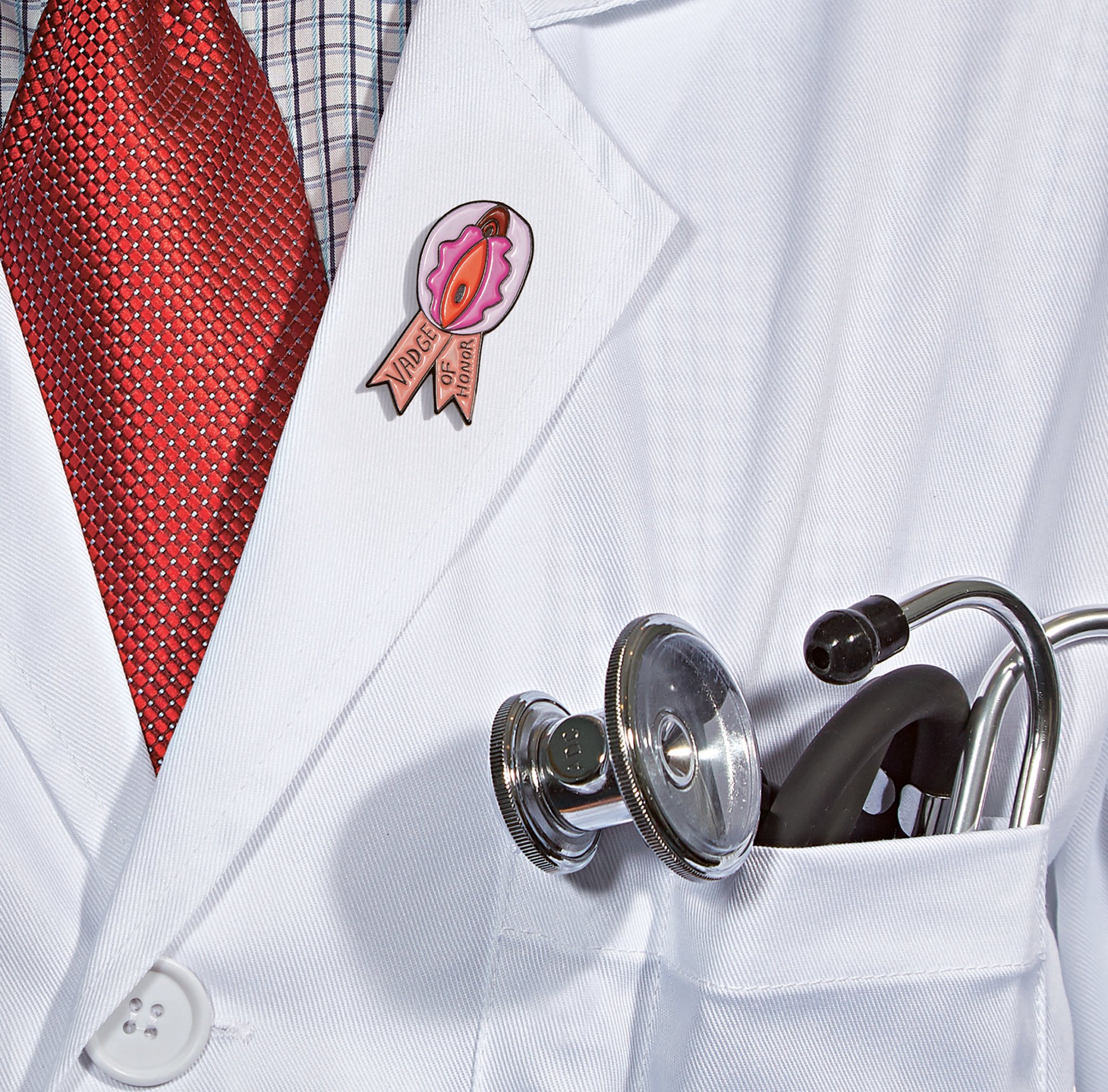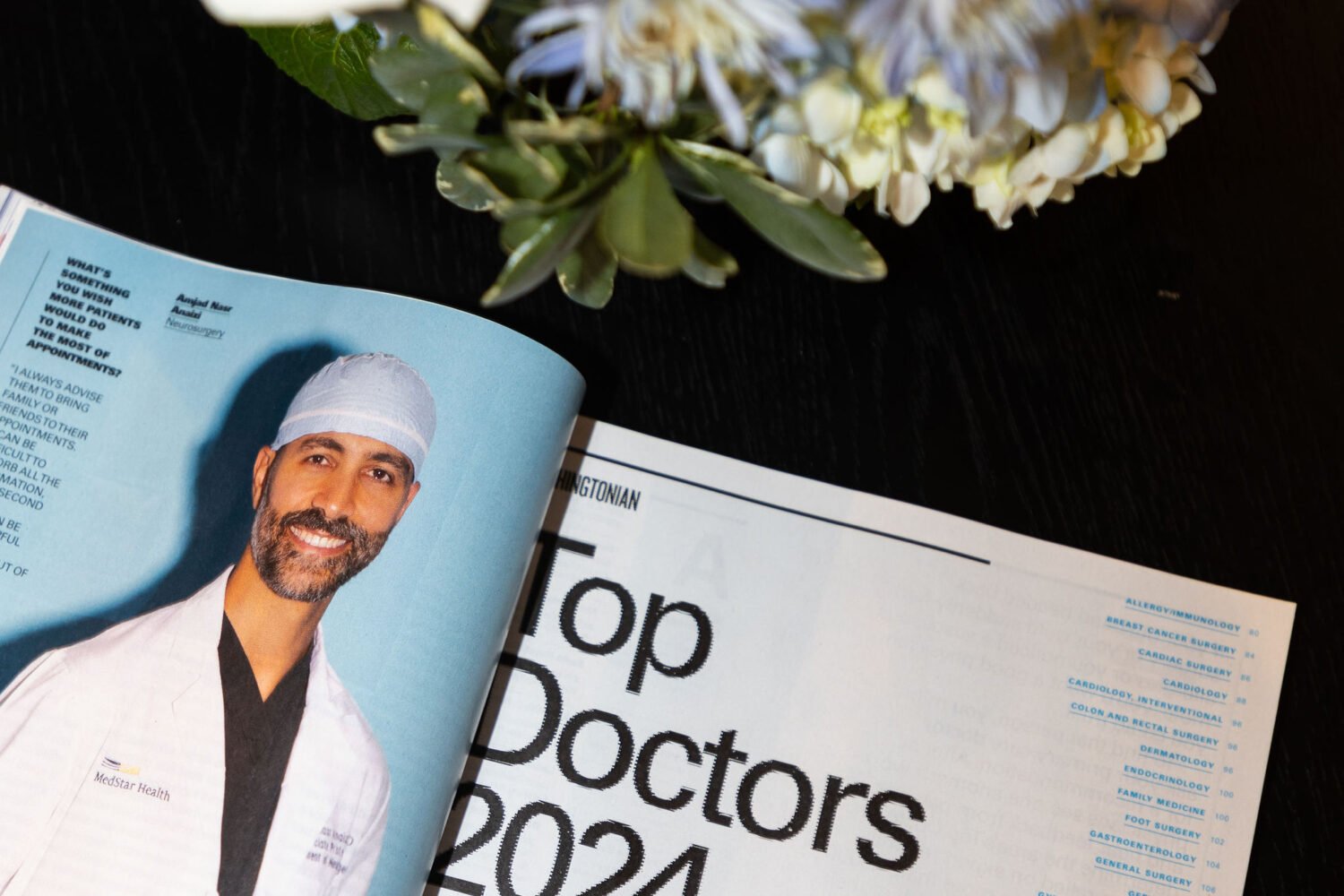The man known to a subset of Washington women as the “menopause whisperer” reaches behind his chair for a set of dilators in sherbet-bright pastels and arranges them on his desk from lavender to baby blue. Or, as he puts it, “from pencil to porn star.”
These silicone instruments are a physical-therapy tool for women struggling to have pain-free sex. Dr. James Simon has them on display in his Dupont Circle office in the same spot where an accountant might stash a calculator. On his lapel, below a cluster of more serious-looking pins, is an enamel vulva that reads VADGE OF HONOR.
He gestures, Vanna White–style, at the rainbow of dilators between us. “So do you have any idea what’s normal? There’s only one that’s the exact norm.”
Simon, an ob-gyn and reproductive endocrinologist, is in his element, which is not the average person’s element: talking about sex. Specifically, talking about postmenopausal sex. Everything that probably makes you blush or squirm seems to delight him. In our hourlong conversation, I’m asked when, outside of a pornographic video, I last saw a penis the size of the largest dilator (“I’m impugning your virtue here a little bit”), in-formed that all our surviving parents and grandparents are still having sex, and given an office tour that includes a stop at a glass case filled with personal devices more associated with a sex shop than with a medical practice. (Rest assured, doctors call them dildos and vibrators, too.)
Though Simon jokingly refers to himself as a “dirty old man,” really he’s an evangelist for full sexual equality, a child of the ’60s who is frustrated that our cultural understanding of women’s sexuality has evolved little in the decades since he went into practice. “It is a horror show that it hasn’t changed,” he says.
According to a 2017 study in the Journal of Sexual Medicine, a majority of women will experience symptoms that can deter or derail their sex lives as they age: pain with sex or touching due to dryness and decreased elasticity of the vagina; low libido; pelvic pain; increased time required to achieve orgasm. These issues are, by Simon’s estimate, “dramatically under-diagnosed.” Of the nearly 2,000 women in the study who had such problems, fewer than 10 percent were being treated by any prescribed therapies. Surely it doesn’t help that, until recently, this battery of conditions, now formally called genitourinary syndrome of menopause, or GSM, was known in the medical community by the apocalyptic-sounding term vulvovaginal atrophy.
Almost none of my colleagues ask, ‘How big is your husband?'” For women struggling with sex, the size of that partner “defines the problem.
That same study found that 81 percent of women suffering from these symptoms weren’t aware that their sexual struggles were a medical condition, and 72 percent had never discussed their symptoms with a health-care professional. They believed that their problems were “just a natural part of aging and something to live with,” according to the report.
“Sex is a difficult topic,” says Sharon Malone, an ob-gyn in DC. “Certainly no one wants to admit that they are having difficulties with sex. And these symptoms, no matter how typical they may be, you don’t know that if you’re experiencing that in isolation.”
Women sometimes wind up in Simon’s office “specifically because they’ve given up—on their doctor, on typical treatments, or, and this is really important, on over-the-counter treatments,” he says. “Almost all of them have tried something that’s over the counter—or in the kitchen. Pick your oil du jour: salad dressing, olive oil, butter.” (Note: If you haven’t tried that already, don’t.)
Now the government is joining the effort: Until January 1, says Simon, “the products for painful sex and dryness of the vagina were considered by Medicare to be for ‘lifestyle choices,’ ” and they weren’t covered—even though comparable treatments for aging men typically were. Amid growing pressure to address “this dramatic dichotomy,” as Simon puts it, Medicare relented. As of this year, drugs that treat painful sex and GSM are no longer excluded from Medicare coverage. But while nearly all private insurers cover most of these treatments, the copays can be high.
Sex isn’t food. It’s not water, it’s not air. It’s something a person can live without. But should you have to? What does it say about our society and our health-care system that so many women have been convinced that a near-universal ailment is a personal failure and a private shame? Why accept the treatable as the inevitable? Achieving real equality for women requires considering the entirety of women’s lives, not just the size of their paychecks or the ceilings on their professional aspirations. It means equality everywhere, even in the most intimate parts of their lives.
“Sexual health is a part of overall women’s health—mental health, your physical health, your psychological well-being,” says Malone. “All of that plays into the same goal that we have, which is making women lead healthy, full, active lives. So I don’t put that at the bottom of the list of things we should be addressing.”
Like so many female experiences, postmenopausal sexual pain is rarely discussed out in the open, and for many it remains a source of mortification. Even in a doctor’s office, with its promise of confidentiality and the knowledge that nothing you say can be embarrassing—They’re doctors! They’ve seen and heard everything!—women can still be skittish about raising an issue as sensitive as sexual pain. “Very rarely” do patients affirmatively bring this up, says Simon.
In Marilyn Jerome’s experience as an ob-gyn in the District, “Women are afraid to talk to their doctors [about sexual pain] and don’t feel comfortable talking to their friends. Some people have screwed up the courage, and then we’re all in. Other times, it’s a passing comment and they wait to see what the doctor latches onto. I’m sure sometimes those passing comments are ignored.”
Unfortunately for women in need, it’s uncommon for doctors to initiate a conversation about sexual pleasure—or lack thereof. “What’s been happening with women is no one has ever asked the question ‘What’s your sex life like?’ ” Malone says. “The reason a lot of doctors don’t ask is because, one, they’re uncomfortable and, two, they don’t really know what the answer is or what the solutions are or how to really address the problem.”
“I can tell you almost none of my colleagues ask, ‘How big is your husband?’ ” says Simon. For married women struggling with postmenopausal sex, the size of that partner “can define the problem. But doctors don’t ask about penis size.”
Malone believes it’s critical for ob-gyns to get comfortable talking about sex. “I’m not waiting on the conversation to just kind of drift around to this,” she says. “I realize that sexual health is an important part of physical health. I would be just as remiss if I didn’t talk about getting your mammogram.”
Erica Palim, 50, underwent a voluntary oophorectomy, or removal of the ovaries, when she was 36. A breast-cancer survivor with the BRCA1 gene who knew she was done having children, Palim wanted to reduce her risk of ovarian cancer. The laparoscopic procedure was “easy,” she says, but the aftermath brought on early menopause, whose symptoms just about blindsided her.
“It felt like there was this whole shroud of secrecy around menopause,” she says. Palim knew to expect something but not what the something would be. She had been receiving “the best of the best” medical care since her breast-cancer diagnosis years earlier. But “my doctors didn’t tell me anything about the fact that I might have decreased libido, arousal, desire, ability to have orgasms.”
Her sex life with her husband had “always been great.” Over the summer following her surgery, “it went to nothing,” she remembers. “At the time, I didn’t know what was happening to me. I didn’t understand it. It was very unsettling, disappointing, and sad.”
Palim stumbled on a Washington Post article that mentioned Simon’s practice; he put her on testosterone, and her condition rapidly improved. But if she hadn’t happened upon that story, “that might have just been the end for me of a part of my life and of my relationship with my husband that was meaningful and fun—and why? Why should I have had to give that up just because nobody bothered to tell me about it?”
Now that her friends are going through menopause, Palim sees some of the other obstacles they’re up against as they adjust to this new stage. “By the time you’re a 50-year-old woman, you’ve been putting your family and kids first for a long time. It’s hard to say, ‘This is about me, and it’s for me.’ ”
As Palim learned, treatments are available to women who seek them out. While it used to be as limited as “hormones or no hormones, and that was all we had,” Malone says, things have improved in recent years. Now options range from lubricants to locally applied vaginal estrogen to systemic estrogen—which plenty of women can’t, or would prefer not to, take—to one of the newest developments, topical laser treatment.
Dr. Jerome is optimistic about the fractional CO2 laser, which works by using energy to create superficial holes in the tissue, thereby stimulating the collagen in the vaginal walls and regenerating vaginal tissue and blood flow. The FDA has approved the treatment but hasn’t given it the indication for GSM specifically—yet. “We’re getting good preliminary data on that,” she says. “We’re just trying to get the studies done. That’s an interesting new horizon, especially for people who can’t use hormones of any variety.”
The vaginal laser requires three treatments six weeks apart, “and then you’re good for a year,” Malone says. It’s a path for breast-cancer patients who can’t take estrogen and for people who don’t want to deal with applying a topical product to their vagina every day for the rest of their sex lives. “For some patients, that just doesn’t work,” says Malone.
First, though, women have to know these treatments exist. While anyone watching TV after 10 pm is all but guaranteed to spot an ad for erectile-dysfunction meds assuring aging men that they, too, can enjoy everyone’s favorite sex position—holding hands from separate bathtubs—female sexual aids have no equivalent cultural footprint.
Assuming women do find out that there are treatments on the market for their sexual needs, they face another obstacle: cost. “I think one of the biggest battles we’re trying to fight, in addition to increasing awareness, is trying to get these medications covered under insurance,” says Malone. “Because, believe it or not, a lot of the remedies we have, particularly topical estrogens, we had a lot of difficulty getting insurance to pay for. And they’re quite expensive.”
“There is some prejudice against women” preventing insurance companies from addressing women’s sexual needs in equal measure to men’s, says Malone. “The notion is: Why are women over 65 having sex anyway? That is the sexist strain running through this. Women are just supposed to be invisible and fade away and not really have these issues addressed.”
Says Palim: “When you look at TV and movies, sex is always two young, hot people. But everybody gets older. My generation of women, we’re going to spend half of our life postmenopausal. That’s a big chunk of time. It’s not really an after-thought anymore.”
This article appears in the May 2019 issue of Washingtonian.


















